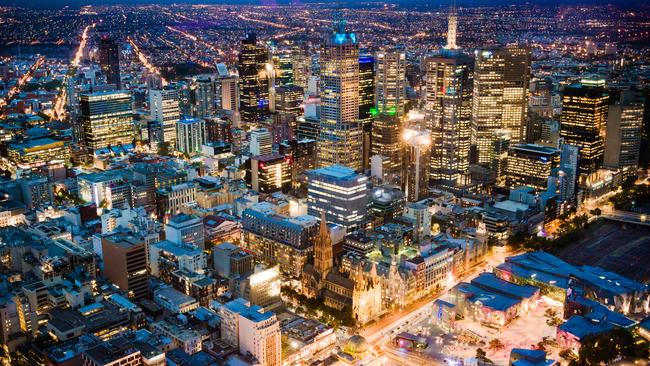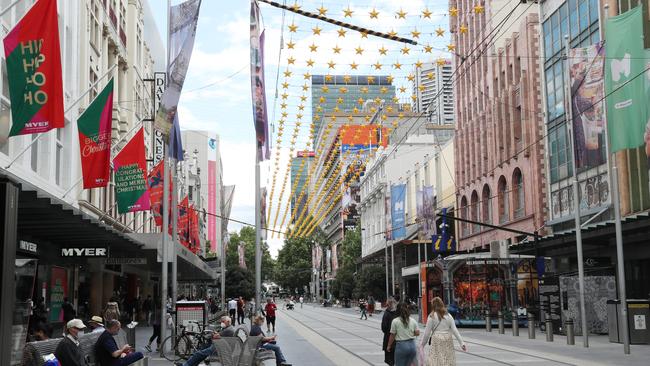Australian cities to shrink as COVID-19 leaves its mark
What will be the long-term effects of the pandemic on the vibrancy, the value and the role of our CBDs? We’ve done the numbers...

One of the concerns arising from the coming of the coronavirus is the impact the contagion and its management has had on the central business districts of our largest cities, and especially Melbourne given the extent of the lockdown in Victoria.
The theory is that office workers may have become conditioned to working from home, and that employers will be only too willing to support a permanent work-from-home arrangement to relinquish some of the cost of accommodation in commercial office buildings.
And that’s just for starters. There’s also the issue that Australia’s hard border closures have halted international visitor arrivals, which affects the demand for city hotel accommodation.
And unless a solution is found to admit foreign students before the beginning of the 2021 academic year, there’s the possibility that yet another tranche (year) of the international student market will be lost.
Indeed, one of the great new additions to the CBD in recent years has been the rise of the student accommodation industry, which has injected youth, life and energy into the city centre and its fringe.
The question city planners, commercial office building owners, investors and others must be asking right now is this: what will be the long-term effects of the pandemic on the vibrancy, the value and the role of the CBD?
Let’s look at the numbers, starting with Melbourne.
I have defined the CBD as comprising the city’s central grid plus all abutting suburbs within a 3km radius of the Bourke Street Mall. This area captures the CBD and its many support functions located in Docklands, Southbank and St Kilda Road as well as suburbs such as Parkville, Carlton, Fitzroy and Collingwood.

This extended CBD contained 448,000 jobs at the time of the 2016 census, up 81,000 on the number five years earlier. If this growth rate was maintained, then by the time the pandemic arrived this year the area probably would have contained 520,000 jobs or thereabouts. The census also shows that 3 per cent of Melbourne’s workforce regularly worked from home.
There is no definitive estimate of the proportion of the workforce that worked from home during Melbourne’s extended lockdown, but I think it was about 45 per cent and possibly much higher for CBD (and fringe) office workers.
The question for city office tower owners and investors (including your and my superannuation funds) is whether my estimate of 45 per cent will revert to 3 per cent in the post-lockdown world next year, thus upholding demand for (and the value of) city office towers, or whether it settles back to a fundamentally higher figure.
What if this proportion reverts to, say, 10 per cent, which is seven percentage points above the long-term average? This equates to 36,000 workers or to about 360,000sq m of office space (at a rough industry average of 10sq m per worker) that no longer would be required.
Of course not all these net new long-term work-from-home workers would otherwise work in an office, let alone in an investment-grade CBD office building, but a proportion would indeed work in just such a commercial office building.
The commercial office market must get every worker who has worked from home during the pandemic back into their former accommodation to hold up demand for floor space, to support rental levels and to keep property valuations from slipping.
I think this is a big ask, especially for off-prime space on the fringe of the CBD. Or at least this is the way it seems to me.
The 2016 census also revealed that on census night the Melbourne CBD (as defined in the map) accommodated 17,000 visitors from overseas, up 7000 from the number five years earlier. At the time the pandemic hit, international visitors to the Melbourne CBD could have been in the order of 23,000 (during a weekday).
A separate Australian Bureau of Statistics tourism accommodation bulletin from 2016 shows 32,000 hotel rooms (with average 81 per cent occupancy) for the Melbourne CBD as defined. This aggregate number of rooms also will have increased by the time of the pandemic. And not all overseas visitors stay in city hotels; some stay with friends and family.
The 2016 census also shows that about 4000 Australian visitors spent census night somewhere within the Melbourne CBD as defined. Based on these estimates (and excluding the troubled hotel quarantine arrangements) I think there would be more than, say, 25,000 hotel rooms underused in central Melbourne during the pandemic.
The hotel industry needs borders to open and flight and travel patterns to be restored to recover demand and to uphold values.
Then we come to the issue of student accommodation. According to the 2016 census some 26,000 international students spent census night somewhere in the Melbourne CBD. This number was up 13,000 over five years. By the time of the pandemic the international student community in central Melbourne is likely to have well exceeded 30,000.
The March border closures stymied part of this year’s foreign student intake; any continuance of these closures into the next academic year will lift vacancies in the student accommodation market.
The CBDs of Australia’s five biggest cities are complex engines with office-worker and shop-worker pistons, supported by the hydraulic hoses of international and domestic visitors, plus students and others who are part of a rhythm that pumps life into the beating heart of our greatest cities.
Whichever way you look at these numbers, these metrics, restitution of the CBD’s way of life post pandemic, let alone in a “living with COVID” scenario, requires full restitution of the pistons, the pipes, the hoses, the coolants and the accelerants that drive these glittering portals to the national and global economies.
Every CBD office worker, shop assistant, international tourist, visitor and student who has made other arrangements, other decisions, as a consequence of the pandemic needs to be re-engaged.
The Sydney CBD is the nation’s largest and most complex workplace destination. Melbourne’s CBD offers the largest collection of international students.
The Adelaide CBD is also relatively strong in international students. The Brisbane CBD is similar in composition to Sydney and Melbourne but across the board is a notch smaller.
The Perth CBD is modest across all my cited metrics: fewer jobs than Adelaide; lowest number of international students; smallest resident population; about the same number of international and domestic tourists as Adelaide. Plus, because of Western Australia’s hard border closure, I suspect Perth office workers are far less likely to have learnt how to work from home.
When the componentry of the CBD is dissected and evaluated the impact of the coronavirus becomes apparent, especially for Melbourne but less so for Perth.
But there is another view. In the post-pandemic world where office workers cosy up to working from home and shoppers order online rather than going “into town”, and foreign students choose Canada over Australia, and international tourists are shut out for years, there’s an argument to say that the CBD will morph into a very different life form.
In a world where work, shopping and culture retreat to the safety and the isolation of the family home (triggering a refurbishment boom for the likes of Bunnings and Harvey Norman), a silent yearning could well emerge for engagement with the kind of exceptionalism that can be delivered only by a CBD.
In this world the leading businesses and a new generation of aspirant workers won’t be satisfied with Zoom calls but will seek out reason to congregate, to collaborate, to test their position (and their power) within the tribe. That interaction must be completed face-to-face and from within a place of authority and prestige.
In this world the CBD and its suburban abutments may well modify and morph as a consequence of the COVID-inspired move into the family home, but a super-premium spine will remain or emerge to accommodate those businesses looking for a flagship, for a statement, for a platform to project the concept and the values of exceptionalism to Australia and beyond.
The problem for the property industry is that this market for exceptionalism is by definition smaller than the market for lifestyle and convenience.
Bernard Salt is managing director of The Demographics Group. Research by data scientist Hari Hara Priya Kannan.




To join the conversation, please log in. Don't have an account? Register
Join the conversation, you are commenting as Logout